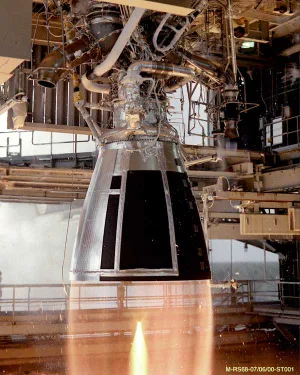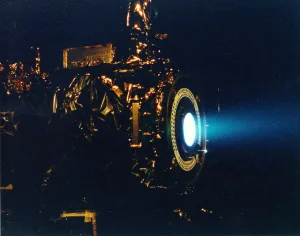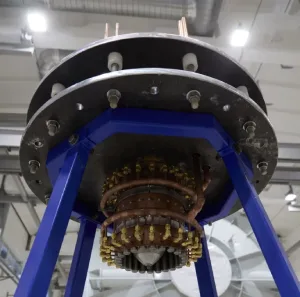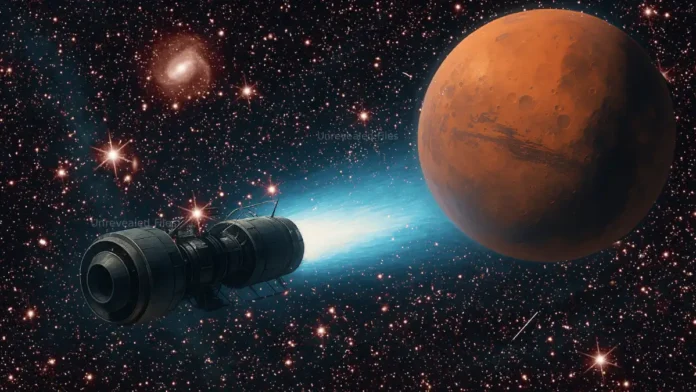Buzzwords like “Mars in 30 Days” make great headlines, and recent prototype claims from Rosatom and other propulsion projects have reignited the hype; however, they risk creating a misleading narrative: that faster rockets and propulsion breakthroughs are the primary barriers to human space travel. They are not.
In reality, the biggest challenges for a Mars mission or interplanetary travel aren’t just about propulsion or speed, but about radiation exposure, spacecraft life-support systems, and the biological limits of the human body in deep space. Faster transit is useful, even necessary in parts, but it doesn’t solve the cascade of engineering, medical, and systems-level problems that determine whether astronauts can go, stay, and return safely. Below, we unpack the latest propulsion technology research and then explain why speed alone is an incomplete and sometimes counterproductive solution to human spaceflight.
Contents
- 1 What’s actually changing in propulsion research
- 2 The “Mars in 30 Days” Promise and Its Problems
- 3 Why faster transit alone is insufficient (and sometimes misleading)
- 4 The biological bottleneck: the human body won’t simply “ride along”
- 5 System-level realities: mass budgets, logistics, and sustainability
- 6 So what should we focus on besides “go faster”?
- 7 Bottom line
- 8 Sources
What’s actually changing in propulsion research



Several propulsion approaches are advancing outside the classic chemical-rocket paradigm:
- Electric (ion / Hall-effect) thrusters. These have been flight-proven on science and commercial missions (e.g., Deep Space 1, Dawn) and deliver very high specific impulse (fuel efficiency) at low thrust. They are excellent for long-duration, fuel-efficient missions, but accelerate slowly; not ideal for fast crewed transits unless paired with very high continuous power.
- High-power plasma concepts (VASIMR and similar). VASIMR has demonstrated steady-state operation in ground tests and aims to provide higher thrust than conventional ion drives when fed by large power sources; it’s promising, but still depends on compact, high-output power systems that are not yet flight-ready at the scale needed for crewed Mars missions.
- New high-thrust plasma prototypes (e.g., recent Rosatom announcements). Lab-scale prototypes claiming multi-newton thrust and high specific impulses have attracted press attention for suggesting dramatically shorter transits. Those claims are interesting but remain to be validated through independent testing, system integration, and flight demonstrations.
- Nuclear thermal/electric, fusion concepts, and beamed propulsion. Each has potential for dramatic performance gains on paper; each also brings unique scaling, safety, regulatory, and technological hurdles before they can shorten crewed trip times in practice. (Nuclear reactors raise regulatory and mass-budget issues; fusion remains experimental; beamed sails favor tiny probes over humans.)
Lessons from Past ‘Fast Travel’ Projects
The idea of dramatically shortening interplanetary travel is not new. Past projects, such as Project Orion in the 1960s, which explored nuclear pulse propulsion, or NERVA (Nuclear Engine for Rocket Vehicle Application), and later concepts like Mars Direct, all promised faster transit times. Yet none moved beyond prototypes due to technical, safety, and logistical hurdles. This historical perspective highlights that every claim of “fast travel” must be weighed against decades of lessons learned, and that speed has never been the sole barrier to human expansion into space.
In short, propulsion tech is making real progress, but most “fast transit” claims are either early-stage prototypes or require complementary breakthroughs (especially in compact, survivable power generation) to support crewed missions.
The “Mars in 30 Days” Promise and Its Problems
The idea of reaching Mars in just 30 days sounds like a science fiction dream turned real. Recently, Rosatom and other groups have proposed concepts for nuclear thermal propulsion and hybrid ion drives that, on paper, could reduce a Mars trip from the traditional 6–9 months to a single month. The claim is simple: less time in space means fewer risks of radiation exposure, bone loss, and psychological stress.
But here’s the problem: a faster rocket does not equal a safer or more viable Mars mission.
- Energy Cost & Engineering Limits – Achieving the speeds needed for a 30-day Mars transit demands immense energy. Nuclear reactors or plasma engines might provide the thrust, but the engineering challenge of safely miniaturizing, cooling, and shielding these systems for a crewed spacecraft is still unsolved.
- Human Biology Doesn’t Scale – Even if you could build a rocket that pushes humans to Mars in 30 days, the human body is not designed to endure the acceleration, vibration, and cosmic radiation at such high speeds. Faster travel may shorten exposure time, but the radiation dose per unit time is far higher because of increased particle collisions.
- Arrival isn’t the End – A spacecraft screaming toward Mars at unprecedented velocity, then has to slow down safely, to enter orbit or land. The braking burns, heat management, and structural stresses required would be unlike anything yet attempted.
- Narrative Distortion – “Mars in 30 Days” grabs headlines, but it distorts the public conversation. The bottleneck for interplanetary travel isn’t just propulsion speed; it’s the combination of life-support systems, radiation shielding, psychological endurance, closed-loop ecosystems, and long-term mission sustainability.
Headlines like “Mars in 30 Days” capture attention but can distort public perception and funding priorities. They risk oversimplifying the real challenges of space exploration, making it seem as if speed is the only obstacle. In reality, sustainable human spaceflight requires integrated solutions across propulsion, life-support systems, radiation protection, and surface operations.
In short, we could one day build rockets fast enough to cut the trip, but speed is not the silver bullet. It’s one piece of a much bigger, more complex puzzle.
Why faster transit alone is insufficient (and sometimes misleading)
1. Power & mass: you trade one problem for another
Electric and plasma drives need continuous high electrical power to produce thrust. To compress transit time, you must increase thrust, which means far more power. That power must come from massive solar arrays, gigawatts of beamed energy, or onboard nuclear reactors. Each of those solutions dramatically increases spacecraft mass, complexity, cost, and safety constraints (shielding, thermal management, regulatory approvals). The mass added for power and shielding cancels some of the speed gains and creates larger engineering and launch challenges.
2. Braking is as costly as accelerating
High cruise velocity reduces travel time but increases the delta-v (change in velocity) needed to slow down and perform orbital insertion or landing. That braking energy must be supplied, often meaning a second engine or propellant reserve, and becomes a major mission-planning constraint. In the extreme, “fast transit” could become a one-way trip unless braking is guaranteed.
3. Collision hazard scales with relative speed
At typical orbital speeds, even millimeter-sized debris is dangerous. Increase relative speed by an order of magnitude, and the kinetic energy of tiny particles grows with the square of velocity, turning harmless dust into vehicle-disabling projectiles. Shielding against high-speed impacts adds mass; maneuvering to avoid debris becomes harder when small course corrections are expensive in delta-v and time.
4. Reliability and abort options worsen
Long-duration, continuously powered propulsion systems are complex and have limited redundancy options once the crew departs Earth. Catastrophic failures in mid-transit are harder to mitigate on a high-speed profile: the window for safe aborts narrows, and emergency return becomes more energy-intensive. Fast missions that rely on sustained high-power operation demand ultra-reliable reactors and fault-tolerant designs that we have not yet flight-proven at crewed scale.
The biological bottleneck: the human body won’t simply “ride along”
Even if you could reliably halve or quarter transit time, many human health problems would remain, and some could actually get worse depending on profiles:
1. Radiation: dose, quality, and biological impact
Shorter trips reduce cumulative time under chronic background radiation, but deep-space radiation is not just a “time” problem. Galactic cosmic rays (GCRs) are high-energy particles that penetrate shielding, cause complex DNA damage, and carry risks for cancer, cardiovascular disease, and cognitive decline. Solar particle events (SPEs) are episodic but can deliver acute doses. Current shielding technologies can partially reduce exposure but not eliminate it for multi-week missions in deep space; the molecular and clinical risks remain active research areas. (Recent studies and mission measurements underline that radiation is a leading barrier to human Mars missions.)
Researchers are exploring innovative ways to protect astronauts from deep-space radiation. Options include water-based shielding, polyethylene layers, and even active magnetic shielding to deflect charged particles. While these technologies can reduce exposure, they add significant mass and complexity to spacecraft design. Even with the fastest rockets, shielding remains a limiting factor, proving that speed alone cannot eliminate the dangers of cosmic radiation.
2. Microgravity: short transit ≠ solved problem
Microgravity causes bone loss, muscle atrophy, fluid redistribution (which can impair vision), cardiovascular deconditioning, immune dysregulation, and neurological changes. Shortening the cruise time from nine months to one month helps, but it does not remove the need for robust countermeasures (resistive exercise, pharmaceutical aids, or artificial gravity). Moreover, if the destination requires long surface stays (Mars surface missions measured in months to years), microgravity problems will re-emerge in habitat design and surface operations.
3. Acceleration tolerance and human performance
Humans can withstand short bursts of high g, but sustained high-thrust profiles that shorten transit time may impose prolonged acceleration or deceleration phases that stress the cardiovascular system, vestibular function, and intracranial pressure. Engineering around human tolerance (g-suits, reclined orientations, controlled thrust profiles) constrains how “fast” you can safely accelerate and decelerate people.
4. Unknowns: reproduction, long-term cognition, aging
We lack reliable data on reproduction, fetal development, and multi-generational effects in deep space. Shorter transit time does not make those unknowns go away; indeed, more frequent missions and longer stays increase cumulative population-level questions for which we have no answers.
System-level realities: mass budgets, logistics, and sustainability
A realistic mission is not just “rocket + crew.” It’s power systems, life-support closed loops, radiation shelters, medical capability, spare parts, and food/water/fuel logistics. Each kilogram devoted to radiation shielding or life-support reduces the mass available for propulsion, payload, and redundancy. Getting people to Mars in 30 days, but without in-situ resource utilization (ISRU) for water/oxygen/fuel, robust habitats, and regenerative life-support, simply moves the logistic bottleneck from the transfer leg to the surface mission.
Reaching Mars quickly is only the first step; sustaining life there is the bigger challenge. Successful missions will rely on in-situ resource utilization (ISRU) to produce water, oxygen, fuel, and even food on the Martian surface. Faster travel reduces transit risks, but a habitable environment, self-sufficient life-support systems, and reliable infrastructure are critical for long-term survival. Without them, speed gains become irrelevant once humans land.
Shorter transit times do little to resolve the psychological and operational stresses of deep-space travel. Isolation, confinement, communication delays with Earth, and the need for precise crew coordination remain major challenges regardless of speed. Mental health support, autonomous decision-making capabilities, and well-designed habitats are just as important as faster propulsion in ensuring mission success.
So what should we focus on besides “go faster”?
Speed is a critical tool in the toolbox, but it must be built into a systems-first roadmap that includes:
- Compact, high-reliability power (safe nuclear reactors or scalable beamed power).
- Radiation mitigation (advanced passive materials, active shielding concepts, biomedical countermeasures).
- Artificial gravity research (short-radius centrifuges, rotational habitats) and improved countermeasures for microgravity.
- ISRU and closed-loop life support so surface missions aren’t permanently supply-dependent.
- Mission architecture that balances delta-v, mass, and safety (including abort capability and redundancy).
Bottom line
Advances like high-power plasma thrusters and nuclear-electric concepts are exciting and will reshape mission planning. But headlines that treat transit time as the single decisive problem misdiagnose the situation. Human spaceflight is a systems challenge: propulsion, medicine, power, shielding, habitats, and logistics must advance together. Speed shortens one axis of risk (time exposed) but amplifies or leaves untouched many others (radiation quality, collision energy, braking energy, mass tradeoffs, and physiological unknowns). Suppose the goal is a sustainable human presence beyond Earth. In that case, we must stop fetishizing “fast” and start engineering the full, integrated ecosystem that will enable humans not just to reach other worlds, but to live there and return home.
Sources
- “Mars in 30 Days: Russia Unveils Prototype of Plasma Rocket Engine.” World Nuclear News, 25 Sept. 2025.
- “Project Orion (Nuclear Propulsion).” Wikipedia, Wikimedia Foundation.
- “NERVA.” Wikipedia, Wikimedia Foundation.
- “Mars Direct.” Wikipedia, Wikimedia Foundation.
- “For Astronaut Radiation Protection, Just Add Water.” European Space Agency (ESA), 27 Sept. 2019.
- Durante, Marco, et al. “Performances of Kevlar and Polyethylene as Radiation Shielding Materials in Deep Space.” Scientific Reports, vol. 7, no. 1, 2017.
- Olson, Alex, et al. “A Review of Magnetic Shielding Technology for Space Applications.” Magnetochemistry, vol. 3, no. 1, 2023.
- “NASA’s Oxygen-Generating Experiment MOXIE Completes Mars Mission.” NASA, 7 Sept. 2023.
- “NASA Locked Them Away for a Year to Test Mars Simulation Survival—What They Did with a PS4 Will Stun You.” The Times of India, 7 Sept. 2024.
- “Human Adaptation to Deep Space Environment” (F. Criscuolo et al., 2020).
- “Overview of Environmental Control and Life Support Systems in Human Space Missions” (Saroja & Bhavani, 2025).
- “Long-term space missions’ effects on the human organism” (Tomsia et al., 2024).
- “Exploring viability of Life Support System for long term human …” (L. Chen et al., 2023).
- “MELISSA: The European project of a closed life support system” (Lasseur et al.).
- “Human Health during Space Travel: State-of-the-Art Review”.
FACT CHECK: We strive for accuracy and fairness. But if you see something that doesn’t look right, don’t hesitate to Contact us.
DISCLOSURE: This Article may contain affiliate links and Sponsored ads, to know more please read our Privacy Policy.
Stay Updated: Follow our WhatsApp Channel and Telegram Channel.












